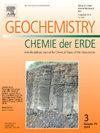Formation process of a newly explored ion-adsorption type REE deposit in Pingtian, Guangdong, South China: A detailed profile analysis
IF 2.9
3区 地球科学
Q2 GEOCHEMISTRY & GEOPHYSICS
引用次数: 0
Abstract
Recently, ion-adsorption-type rare earth element (REE) deposits have been explored in Nanxiong Basin (South China), with an estimated total reserve of >100 million tons. The formation of ion-adsorption-type deposits is closely linked to the weathered crust of their parent granitic rocks. To better understand how the weathered crust influences the formation of ion-adsorption type REE deposits, this study presents detailed research on the relationship between the characteristics of the weathered crust and parent rock in Pingtian Town, Nanxiong Basin, Guangdong Province, through a detailed profile analysis. The U![]() Pb dating of zircon and apatite indicates that the parent rock (biotite monzogranite) was formed at ca. 220 Ma, which provides favorable metallogenic conditions for the formation of the weathered crust. Minerals such as monazite, zircon, apatite, and plagioclase play critical roles in the formation of the weathered crust. Monazite and plagioclase are the main controlling minerals for REE enrichment in the weathered crust. Monazite, influenced by apatite, determines the REE distribution pattern in the crust, with a particular emphasis on light rare earth elements (LREE). Zircon, being resistant to weathering, leads to the preferential enrichment of LREE in the weathered crust and limits the accumulation of heavy rare earth elements (HREE). Plagioclase, through weathering into kaolinite, provides an adsorption medium for ionized REE. In addition, trace element analysis of zircon and apatite, as well as geochemical studies on the parent rock, indicate that the parent rock belongs to a moderately differentiated granite. The degree of granite differentiation impacts REE enrichment in the weathered crust. The higher the degree of differentiation, the more ionized REE elements and adsorption media are provided, facilitating the formation of ion-adsorption type REE deposits. This highlights the importance of detailed profile geochemical analysis in revealing the genesis of ion-adsorption-type REE deposits.
Pb dating of zircon and apatite indicates that the parent rock (biotite monzogranite) was formed at ca. 220 Ma, which provides favorable metallogenic conditions for the formation of the weathered crust. Minerals such as monazite, zircon, apatite, and plagioclase play critical roles in the formation of the weathered crust. Monazite and plagioclase are the main controlling minerals for REE enrichment in the weathered crust. Monazite, influenced by apatite, determines the REE distribution pattern in the crust, with a particular emphasis on light rare earth elements (LREE). Zircon, being resistant to weathering, leads to the preferential enrichment of LREE in the weathered crust and limits the accumulation of heavy rare earth elements (HREE). Plagioclase, through weathering into kaolinite, provides an adsorption medium for ionized REE. In addition, trace element analysis of zircon and apatite, as well as geochemical studies on the parent rock, indicate that the parent rock belongs to a moderately differentiated granite. The degree of granite differentiation impacts REE enrichment in the weathered crust. The higher the degree of differentiation, the more ionized REE elements and adsorption media are provided, facilitating the formation of ion-adsorption type REE deposits. This highlights the importance of detailed profile geochemical analysis in revealing the genesis of ion-adsorption-type REE deposits.

广东平田新发现离子吸附型稀土矿床的形成过程:详细剖面分析
近年来,中国南部南雄盆地发现了离子吸附型稀土矿床,估计总储量达1亿吨。离子吸附型矿床的形成与其母质花岗岩的风化壳密切相关。为了更好地了解风化壳对离子吸附型稀土矿床形成的影响,本文通过详细的剖面分析,对广东南雄盆地平田镇风化壳特征与母岩的关系进行了详细的研究。锆石和磷灰石UPb定年表明母岩(黑云母二长花岗岩)形成于约220 Ma,为风化壳的形成提供了有利的成矿条件。独居石、锆石、磷灰石和斜长石等矿物在风化地壳的形成中起着至关重要的作用。独居石和斜长石是风化壳稀土富集的主要控制矿物。受磷灰石影响的独居石决定了地壳中稀土元素的分布模式,其中轻稀土元素(LREE)尤为突出。锆石具有抗风化作用,导致轻稀土元素在风化壳中优先富集,限制了重稀土元素(HREE)的富集。斜长石经风化成高岭石,为离子化稀土提供了吸附介质。锆石、磷灰石微量元素分析及母岩地球化学研究表明,母岩属于中等分异花岗岩。花岗岩分异程度影响风化壳中稀土元素的富集。分异程度越高,提供的离子化稀土元素和吸附介质越多,有利于离子吸附型稀土矿床的形成。这凸显了详细剖面地球化学分析对揭示离子吸附型稀土矿床成因的重要性。
本文章由计算机程序翻译,如有差异,请以英文原文为准。
求助全文
约1分钟内获得全文
求助全文
来源期刊

Chemie Der Erde-Geochemistry
地学-地球化学与地球物理
CiteScore
7.10
自引率
0.00%
发文量
40
审稿时长
3.0 months
期刊介绍:
GEOCHEMISTRY was founded as Chemie der Erde 1914 in Jena, and, hence, is one of the oldest journals for geochemistry-related topics.
GEOCHEMISTRY (formerly Chemie der Erde / Geochemistry) publishes original research papers, short communications, reviews of selected topics, and high-class invited review articles addressed at broad geosciences audience. Publications dealing with interdisciplinary questions are particularly welcome. Young scientists are especially encouraged to submit their work. Contributions will be published exclusively in English. The journal, through very personalized consultation and its worldwide distribution, offers entry into the world of international scientific communication, and promotes interdisciplinary discussion on chemical problems in a broad spectrum of geosciences.
The following topics are covered by the expertise of the members of the editorial board (see below):
-cosmochemistry, meteoritics-
igneous, metamorphic, and sedimentary petrology-
volcanology-
low & high temperature geochemistry-
experimental - theoretical - field related studies-
mineralogy - crystallography-
environmental geosciences-
archaeometry
 求助内容:
求助内容: 应助结果提醒方式:
应助结果提醒方式:


